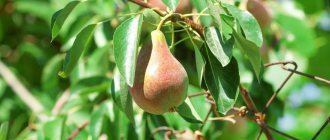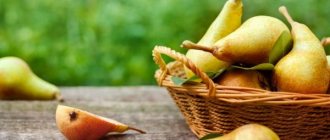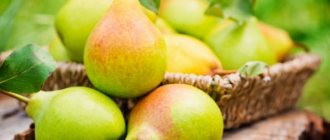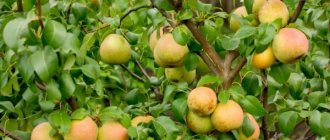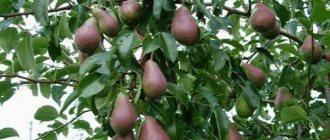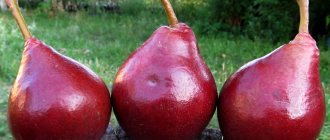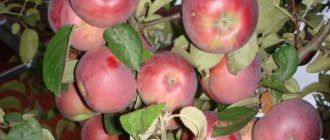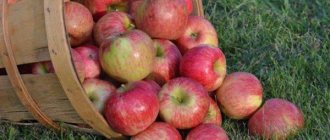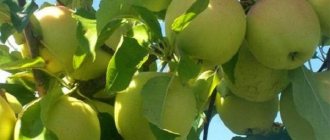Pear Tenderness.
Description of the variety
Pear belongs to the varieties of early autumn ripening. The Tenderness variety has sufficient frost resistance and is successfully grown even in the Krasnoyarsk region.
Characteristics of wood
The tree is small and rarely exceeds 4 meters in height. The crown is sparse, wide, rounded. The bark on the trunk and skeletal branches is dark brown. The leaves are large, dark green, and have an elongated ovate shape. The leaf plate is glossy.
Description of fruits
Pear fruits Tenderness.
The average weight of one fruit is 150-200 grams. The pear shape is standard, slightly elongated. The main color of ripe fruits is yellow.
There is a slight pink blush on the surface. Pears are tender, sweet, buttery, with a pleasant sourness and aroma.
The harvest is harvested from the trees in early September. The shelf life of the fruit is up to 30 days.
Planting pear Tenderness
The plant should be planted in the spring, in early March. This way the tree will be more resistant to temperature changes and diseases. You need to decide on a landing site. It is necessary to give preference to permeable soil that receives a sufficient amount of oxygen. The acid-base balance level should be no more than 4%. If you know that groundwater comes close to the roots, you need to install a drainage system in the ground.
The seedling must be 2 years old, without damage or disease. The best development is observed in those representatives whose root length is 20-25 cm. It is important to prepare the planting site in advance. The dug hole should be about 100 cm deep and up to 60 cm wide. Organic fertilizers (humus, mullein or compost) in an amount of 7 kg are poured into it. After 2 weeks, when all the nutrients have penetrated the soil, the seedling can be planted. The roots are evenly distributed along the entire perimeter of the hole, covered with soil and compacted thoroughly. At a distance of 10 cm from the seedling, a metal peg should be placed, which will serve as a support. As the seedling develops, you need to increase the size of the peg to which you will tie the plant.
Optimal timing
Pear seedlings can be planted in autumn (first half of October) or spring (late - early March). It is best to carry out the procedure in the spring: at this time, the flow of plant juices is activated, which ensures increased rooting. In addition, spring planting makes it possible to prepare a young plant for winter frosts, which greatly increases its chances of overwintering safely.
The variety is able to bear fruit, regardless of weather conditions. But in order to increase productivity and get at least 45 kg per plant, it is recommended to spray trees during the ovary period
Choosing the best seedling when purchasing
Choosing a high-quality seedling is the main condition for growing a productive pear orchard: this is the only way to ensure good fruitfulness of the plant, as well as the fastest possible rooting.
To do this, when selecting planting material for Tenderness pears, you should definitely remember that a high-quality seedling:
- no older than 1-2 years;
- characterized by a branched rhizome with a diameter of about 60–80 cm;
- preserves soil in the root zone;
- has no signs of damage or infection by fungi or infections.
Choosing a place to plant a pear
The place for the pear is chosen long before planting. The culture requires a special microclimate, on which not only rooting activity, but also future productivity depends.
The ideal place for planting a seedling must meet the following requirements:
- be in a draft-free and well-lit area;
- have a low level of groundwater (not higher than 2.5 m);
- be away from mountain ash (the source of all kinds of infections);
- be located no closer than 4 meters from garden buildings or tree-like vegetation.
The plant is heat-loving and requires a lot of sunlight, so the close proximity of other trees blocking the light can be harmful.
The pear is not picky about the soil: the plant readily develops and bears fruit in almost any type of soil. However, the highest yields are observed on well-fertilized clay soils with a high agricultural background.
Landing technology
Before planting, the seedling must be prepared - to do this, it is soaked in clean water at room temperature for 24 hours. This helps activate the plant's root system and metabolism. To increase the effectiveness of the procedure, special growth activators (Kornevin, Zircon or sodium humate) are added to the water.
Reviews
Irina
Serpukhov
It was not for nothing that the variety was named by this name. The fruits are really so tender and tasty that they simply melt in your mouth. Unfortunately, pears don’t last long, but they are great for canning.
Anton
Ryazan
The tree is compact, hardy and very productive. Growing this variety is a pleasure, because Tenderness has practically no disadvantages and has many advantages.
Stepan Vladimirovich
Vyazma
The variety is simply amazing. The tree is not at all fussy and quickly took root in its new location. My dacha is located quite far from home and I don’t go there often. However, even with such irregular care, the pear pleases me with a good harvest every year.
Planting and care
It is best to plant a pear in the spring, so that the plant has time to adapt to new conditions before the onset of frost. But spring planting requires regular watering. It is advisable to have a sunny place, on the south side of the garden, protected from strong winds. In order to form branches of the 2nd and 3rd order, at a young age the plant needs systematic shortening. The process of cultivation and care is no different from the generally accepted one.
Tenderness is often considered by breeders as a donor of precocity, high winter hardiness and disease resistance. In the garden, a tree can show itself as a healthy and productive crop. True, opinions differ greatly regarding the taste of the variety, and the keeping quality of the fruit is low.
Landing
Seedlings of this variety take root best if they were planted in early spring and in a planting hole prepared in advance. A lot of useful information and tips on planting pear trees of the Tenderness variety can be found by clicking on the links below.
How to plant a pear tree correctly
At what distance to plant pears?
How to choose pear seedlings
How to replant a pear
Pear care Tenderness
To grow and harvest a good harvest of fruits, it is necessary to provide the tree with proper care.
Despite the fact that the Tenderness pear is characterized by resistance to fungal diseases and insect pests, it is recommended to carry out preventive spraying and treatment of the plant annually. This crop is too sensitive to drought, so do not forget to regularly water the pear abundantly. After each watering, you need to loosen the soil to open up access to oxygen.
Watering
The intensity of irrigation depends on the average daily air temperature and the time of year. In spring and autumn, the pear is watered once a month; in hot summer, the frequency of watering is increased to 2-3 procedures per month.
The amount of water added depends on the age of the seedling. Young plants need no more than 10–15 liters of water; as the tree grows, the amount of liquid is increased to 30 liters. Adult pears are watered until the water completely wets the top layer of soil to a depth of 60–80 cm.
For irrigation, use only clean and well-settled water, heated to air temperature. In spring and autumn, water is applied at the root, in the tree trunk circle; in summer, watering at the root is alternated with sprinkling.
The main mistakes made when watering Tenderness pears:
- watering the day after rain (at least 3 days must pass after precipitation);
- lack of a tree-trunk circle for watering;
- excessive moisture (the soil on the site should dry out periodically);
- neglecting watering after planting a seedling.
It is believed that it is best to carry out irrigation work in the morning or evening, when there is no direct sunlight.
Fertilizer application
For 1-2 years after planting, the pear does not need fertilizer. If all the rules for preparing the soil are followed, the previously added compounds are quite enough to provide the tree with all the necessary substances. Consequently, fertilizing begins only 3 years after planting, and then is carried out annually.
- The first is carried out at the beginning of flowering, using a solution of potassium nitrate (30 g/10 l of water). The rate of working solution per plant is about 5 liters.
- The second time the fertilizer is applied during the phase of active fruit formation. A superphosphate solution (50 g/10 l) is used as fertilizing, with about 7 l of working fluid added to one plant.
The variety needs feeding. There should be 2 of them during the entire growing season
Trimming
The formation of a pear is carried out over 5–6 years from the moment of planting. During this period, the main shoots grow on the tree, on which fruit branches subsequently appear.
The first pruning procedure is done immediately after planting - all branches are shortened to the same length, cutting them off by at least a third. The next time the shortening is done in June. On the seedling, the 3 most developed shoots are left at the same level, the remaining branches are cut off. As the pear grows on the tree, another 4-5 tiers of branches are formed, similar to the first.
At the beginning of March, you need to remove damaged and dry branches that absorb too many useful substances. At the end of October, you should thin out the crown and trim its height a little
How to prune a pear in spring (video)
When growing, summer residents and gardeners are advised to pay attention to the fact that the variety reacts extremely negatively in dry years to insufficient soil moisture in the tree trunks, therefore irrigation measures, especially at the stage of flowering and fruit formation, should be as abundant or regular as possible.
Care
For pears of this variety, it is enough to carry out standard agrotechnical procedures, such as watering, fertilizing and pruning. The articles selected below contain many useful materials and recommendations for growing Tenderness trees.
How to care for a pear Pruning a pear Pruning a columnar pear Treating a pear from diseases and pests Feeding a pear How to water a pear
Advantages and disadvantages
It cannot be said that the “Tenderness” pear has a long list of advantages. There are not many of them, but each is quite significant and sometimes plays an important role when choosing a variety. Let us describe in more detail the main advantages that made this variety so popular among Russian summer residents.
First of all, it is frost resistance. In most regions of our country, winters are very cold, and few species are able to survive them. Choose "Tenderness" and you won't have to worry. Trees can withstand frosts down to -40°C.
Regardless of weather conditions, the pear produces a large harvest. From one tree you can collect about 30 kilograms. To increase this indicator, you can spray with various substances. They are able to increase productivity up to 45 kilograms per tree.
“Tenderness” is unpretentious in care. This plus will help you save a lot of time and effort without sacrificing the volume of your harvest. The variety is very resistant to fungal diseases and various pests.
The trees are very compact in size. There is always a place for them even in small garden plots.
Due to their presentable appearance, pears are a popular item in many grocery stores.
As mentioned above, the fruits of “Tenderness” have a sweet taste with a sour note. Many gardeners claim that pears are pleasant to eat fresh. However, this variety is often used in the preparation of desserts. For example, they become the basis for preserves, jams and compotes. Or filling for sweet pastries. Baby food is also prepared from these pears.
As you can see, the variety does not have many advantages. However, it has even fewer disadvantages, and they are practically insignificant.
- Firstly, it has a short shelf life. The harvested crop lasts no more than one month (plus or minus a week) before it becomes unusable.
- Secondly, trees are somewhat demanding of moisture and require regular watering during dry seasons.
Diseases and pests
Resistance of the pear variety Tenderness to diseases is at a high level, however, in order to prevent infection, it is necessary to periodically carry out preventive measures. In the selection of articles below, you can find detailed instructions on protecting a tree.
Dangerous Pear Pests
Pears often suffer from pests, they affect the leaves, bark and fruits.
In this article, we have selected 11 of the most harmful insects that harm pear trees, and also ways to destroy them.
Diseases of pear trees
To get what they cherish, gardeners have to work hard, and the reason for this is pear diseases.
Read about 19 common pear diseases and how to combat them.
Characteristics of the variety
- The fruiting period for Tenderness begins in the 4th year after planting a two-year-old seedling;
- ripening period - early autumn;
- The yield is stated to be high. According to information from Internet sources, it is up to 40 kg per tree;
- flowering occurs late, which helps to avoid damage from frost;
- According to reviews, in the first year or two of flowering the pear does not set fruit;
- The plant has good immunity, leaves and fruits are highly resistant to scab;
- Winter hardiness of Tenderness in the conditions of the Moscow region is good. Gardeners in the Nizhny Novgorod region note that the wood is resistant to frost, but the buds suffer greatly. The author of the variety, however, pointed out that after thaws, which were followed by severe frosts, damage was observed in the trees;
- The shelf life of the fruit is insufficient - about 2 weeks. If the fruit is overripe, the pulp inside becomes brown and inedible;
- The purpose of using the fruit is for table use.
Description of pear fruits variety Tenderness
The fruits are regular in shape, cube-shaped or round, with a smooth surface; sizes within one tree can vary greatly (from 100 to 200 grams), with an average weight of about 150 grams.
At removable maturity, the main color of the skin is rich green with multiple gray subcutaneous dots and a very faint pink blush on the sunny side. The peduncle is of medium length and thickness.
The pulp is initially white, then becomes darker as it ripens. Its consistency is tender and melting, its taste is sweet and sour - the tasting score varies from 3 to 4 points.
Important! When fully ripe, the pulp of the fruits of the Tenderness variety turns brown and becomes unsuitable for consumption and processing.
The pear contains the following elements:
- sugar – 21%;
- organic acids – 0.35%;
- ascorbic acid – 17.0 mg;
- catechins – 10.4 mg.
The yield from one tree approaches 40 kg. The purpose of the fruit is dessert; small pears are rarely preserved in the form of compotes.
The shelf life varies significantly depending on the time of collection and the place where the tree grows - according to various sources, it ranges from 2 weeks to 1 month.
Preparing for winter
Although columnar varieties of pears have increased resistance to frost, in the conditions of central Russia they need to be insulated before winter. Young seedlings especially need this procedure, because their root system is not yet sufficiently formed.
There are several important agricultural techniques that allow trees to survive even the harsh Siberian winters:
- After the leaves fall, they, along with the fallen dry fruits, are removed and burned. This allows you to get rid of overwintering pests and pathogens.
- At the end of autumn, whiten the pear trunks with water-based paint with lime or chalk diluted in it. This procedure helps protect the bark from cracking resulting from temperature changes.
- Cover the trunk circle with a twenty-centimeter layer of sawdust or straw.
The first few years of young trees are protected by the apical buds, since they are very tender and can die from frost. For this, various materials are used, such as plastic bags - they are put on tree branches. Snow is considered a good protection against frost - it is used to cover the tree trunk right down to the base of the skeletal branches. It is permissible to wrap small trees in non-woven material, and throw a snowdrift on top of it.
For trees that are three years old or more, the trunk is protected by wrapping it in paper and carefully tying it with rope. Ruberoid or ordinary coniferous branches, which are tightly wrapped around the trunk and tied to it with a rope, will help protect the plant from rodents. The young seedling is completely covered with coniferous branches.
Harvest and storage
The fruits are collected in the second or third ten days of September. The ripeness of fruits is determined by several criteria. First of all, this is indicated by the timing of the growing season, as well as the characteristic color of pears - they become a rich yellow color, and on the most illuminated parts of the fruit a characteristic dark pink blush appears. The fruits are picked by hand: in the phase of full ripeness they are perfectly separated from the branches.
After harvesting, the harvest is laid out in small wooden or plastic boxes, in one layer. Pears are stored in a basement or cellar: at a temperature no higher than +10°C and a humidity of about 85%, they can successfully maintain their freshness for no more than 1–2 months. However, to do this, they should find a separate place, away from other fruits or vegetables, and should also be placed at a distance of no closer than 15 cm from the walls of the storage (otherwise the crop will be damaged by fungi). The harvest can be stored in the refrigerator for no more than 3 weeks.
Tenderness is one of the most popular pear varieties, which has gained wide success among plant growers. The plant is resistant to many common diseases and insect pests, and its fruits are distinguished by excellent taste. Anyone can grow this variety: to do this, you need to follow the recommendations described above.
Description and characteristics
A tree of this species can be distinguished by its rather tall growth. It reaches 6 meters in height. The crown has the shape of a narrow pyramid. The leaves are small, dark green, round with a pointed tip, and have a smooth surface. The flowers are distinguished by their snow-white hue and fragrant scent.
The bulk of the fruits are formed on the side shoots. The pears themselves grow quite large. The length of the fetus can reach 12 centimeters or even more. The weight of one of them varies from 150 to 200 grams. The fruits are basically the same as for selection. The color of pears is yellow with a pinkish blush. A waxy coating can be found on the peel. The flesh color is creamy.
The taste of pear is sweet, rich, with a slight sourness.
Columnar pear planting technology
- If you don’t know how to plant a columnar pear, then we will try to describe the entire planting process in as much detail as possible.
- The best time to plant columnar pear seedlings is spring, this way your tree will have time to get stronger before the onset of cold weather.
- A couple of days before planting, prepare the planting holes.
- It is important not only to dig holes, but also to determine the necessary distance between several seedlings. It is optimal to maintain a distance of 50 cm between columnar pear seedlings, and approximately 100-150 cm between rows. In this way, you will provide the seedlings with an optimal flow of fresh air and sunlight. And this is the key to the health of your trees.
- The size of the planting hole should be large enough, approximately 80 cm deep and 60 cm wide. Focus on your seedlings and their root system in a straightened form.
- Prepare the holes. To do this, you need to add about 8-10 liters of water to each. Wait until the water is absorbed and add 2-3 buckets of humus mixed with sand in a ratio of 2 to 1 to each planting hole.
- Mix the soil removed from the hole with superphosphate and potassium sulfate.
- Next, prepare the seedlings. It is important that the root system of the seedlings is soaked in water. To do this, they can be placed in a container of water for a while.
- Place a third of the soil at the bottom of the planting hole, then place the seedling on this layer and carefully straighten the roots.
- Pour the rest of the soil on top and compact the surface with your hands.
- Water each seedling generously; for convenience, you can make holes around the plant.
- Immediately place a support for the columnar pear.
Planting a columnar pear - video
Reviews from gardeners
“Once I was visiting a friend in Stavropol, and he treated me to Tenderness pears. I myself am an avid summer resident, so I was inspired to plant this variety on my plot - I really liked the fruits for their juiciness. I bought the seedlings from a friend and they took root quickly. The trees have developed well and are already giving me fruits. And this despite the fact that the climate in the Urals is more severe than that of the southerners.”
“I’ve been growing “Tenderness” for the 5th year now. The fruits are so fragrant and sweet that in August you have to practically fight off the gourmet bees in order to collect the harvest. The only drawback for me is that pears do not store well in winter. So for the New Year we have to serve guests only fruits canned in syrup. But they also go with a bang.”
“Grandfather has several varieties of pears growing in his garden, but my children got into the habit of carrying around Tenderness. Ripe fruits do not fall to the ground, but hang staunchly on their tails. So the little boys themselves climb the tree and gorge themselves on delicious fruits until their grandfather drives them away.”
Daria, Nikolaev region:
“Grushka Tenderness has been bearing fruit for us for three years now. Last summer was very hot, and the tree drooped slightly - it doesn’t like this kind of weather. To prevent the fruits from falling off before they have time to ripen, my husband and I generously watered the lower part of the trunk and the ground around every day (fortunately, we live in the country in the summer). So the fruits turned out to be surprisingly juicy. And this September we harvested an even larger harvest.”
“Our garden is more than half a century old, and it is famous for its variety of fruit trees. Recently we planted several more varieties, and among them was the “Tenderness” pear. This year we received our first harvest of fruits, although only a dozen, but quite tasty. During this time, the tree has bravely endured our winters and rainy autumns. The whole family loved the pears and truly lived up to their name. My wife is looking forward to next year to make delicious, aromatic jam from the fruits.”
